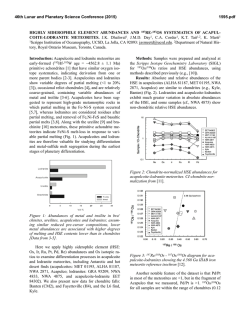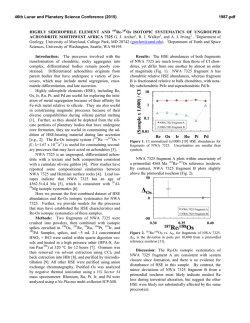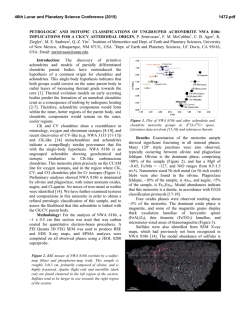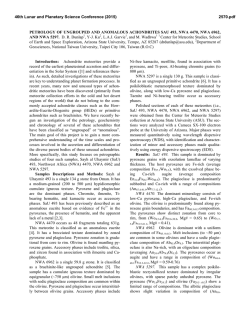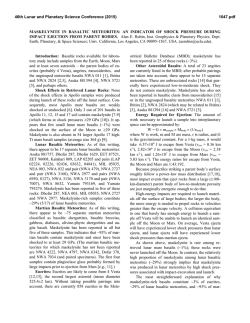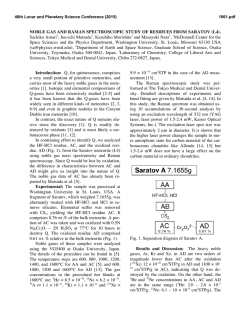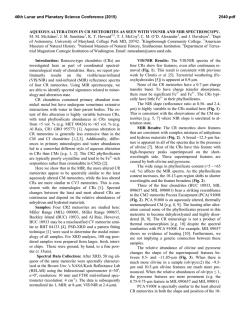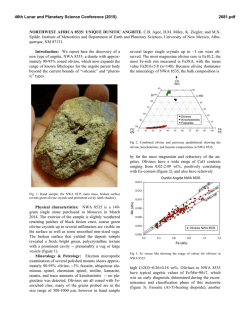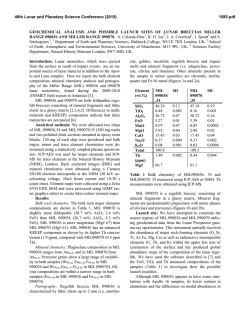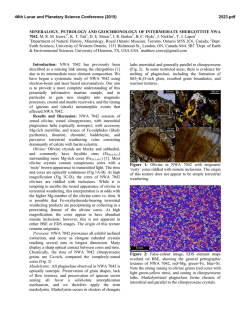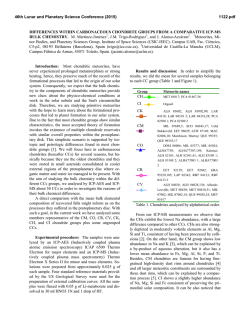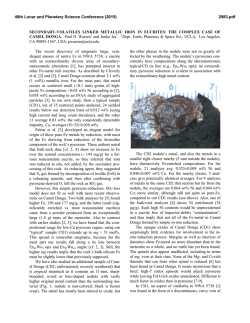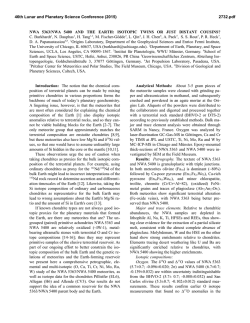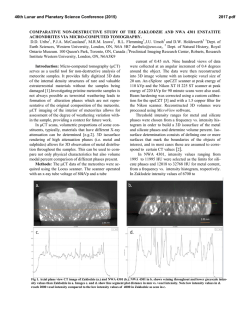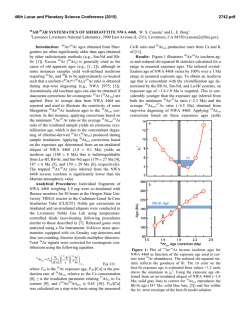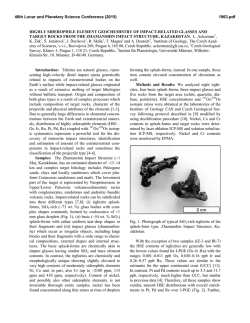
HIGHLY SIDEROPHILE ELEMENT ABUNDANCE AND OS
46th Lunar and Planetary Science Conference (2015) 1254.pdf HIGHLY SIDEROPHILE ELEMENT ABUNDANCE AND OS ISOTOPE SYSTEMATICS OF PARTIALLY MELTED, FEO-RICH ACHONDRITE METEORITES. James M.D. Day1, Paul H. Warren2 1 Scripps Institution of Oceanography, La Jolla, CA 92093-0244, USA ([email protected]) 2Earth, Planetary & Space Sciences, UCLA, Los Angeles, CA 90095, USA Introduction: An increasing number of primitive achondrite meteorites are being recognised with FeOrich compositions, suggesting an origin from oxidized parent bodies. FeO-rich primitive achondrite meteorite types include the brachinites, brachinite-like achondrites (Northwest Africa [NWA] 5400, NWA 6077, Zag (b)), Graves Nunataks (GRA) 06128/9, Tafassasset, Lewis Cliff (LEW) 88763 and NWA 6693 [1-4]. High-FeO partially-melted achondrites are not only important for examining the nature of pre-cursor parental materials forming planets and planetesimals, but also for comparison with some iron meteorite groups (e.g. IVA, IVB), for which complimentary oxidized silicate mantles have been proposed (cf [6,7]). Here we present new highly siderophile element (HSE: Re, Os, Ir, Ru, Pt, Pd) abundance and 187 Os/188Os data for poikilitic cumulate NWA 6693, brachinite ALH 84025, and newly recognized brachinite-like achondrites, MIL 090405 and MIL 090206 [8]. We compare these data with results from LEW 88763 [5] and a new dataset of chondrite meteorite falls [9]. Methods: Os isotope and HSE abundance analyses were performed at the Scripps Isotope Geochemistry Laboratory, using methods described in [5]. Four separate analyses of the CV3 chondrite Allende, in addition to new chondrite fall data, are consistent with published literature data (Fig. 1a) [10]. Results: HSE abundances of ALH 84025 are similar to brachinites reported previously [2], with characteristic low Ir abundances, compared with Os and Ru (Fig. 1b). NWA 6693 has lower absolute HSE abundances and a somewhat ‘mirrored’ pattern to LEW 88763. MIL 090405 and MIL 090206 have similar HSE patterns to NWA 5400, with Os, Ir, Ru and Pt abundances ≥CI-chondrite, and strong Pd depletions. Many of the new chondrite falls lie along a 4.568 Ga Solar System initial (SSI) reference isochron, suggesting limited disturbance of these samples (Fig. 2). Some fragments of Murchison show recent, relative enrichment of Re, plotting to the right of the 4.568 Ga isochron line. None of the new FeO-rich partially melted achondrites lie on the SSI reference isochron, with MIL 090405, MIL 090206, and LEW 88763 indicating Re-loss or Os-gain, and ALH 84025 and NWA 6693 being slightly offset to the right of the reference isochron. Measured 187Os/188Os for MIL 090405 and MIL 090206 are nearly identical and in the range of ordinary or enstatite chondrites. NWA 6693 has radiogenic 187Os/188Os (0.1339). Figure 1: CI-chondrite normalized HSE abundances for (a) chondrite falls, including Allende, Murchison, Chelyabinsk, Richardton, Peace River and Kunashak, and (b) FeO-rich primitive achondrite meteorites. Figure 2: 187Re/188Os-187Os/188Os diagram for chondrites and primitive achondrites. Line is the 4.568 Ga SSI reference isochron. Symbols same as for Fig. 1. Published data from [10]: black = carbonaceous; grey = enstatite; white = ordinary/rumuruti chondrites. 46th Lunar and Planetary Science Conference (2015) Discussion: ALH 84025 falls on the same trend in Pt/Os-Pd/Os space to other brachinites and the GRA 06128/9 meteorites (Fig. 3). Absolute and relative abundances of the HSE in GRA 06128/9 and brachinites are consistent with removal of metal of variable S content under unusual partitioning, or two-stage fractional crystallization of the HSE [2]. Low Pt/Os and Pd/Os in brachinites make them clearly distinct from brachinite-like achondrites, or NWA 6693. LEW 88673 lies within the range of carbonaceous chondrites, consistent with limited partial melting or metal /sulfide melt-loss from the meteorite [5]. MIL 090405, MIL 090206 and NWA 6693 have Pt/Os >2 and higher than in chondrite meteorites (Fig. 3). High Pt/Os is predicted in metal liquids during liquid metal-solid metal fractional crystallization processes (e.g., [6,7]). Figure 3: Pd/Os versus Pt/Os for new chondrite falls (small unfilled circles), achondrites, published chondrite data (cc, ec and oc = carbonaceous, enstatite and ordinary chondrites, respectively), ureilites [11], and brachinites and brachinite-like achondrites [2]. MIL 090405, MIL 090206 and NWA 6693 have elevated Pt/Os (>2). Melt calculations model lines show the composition of residues that result from single episodes of batch melting, with variable S content, and are from [2]. Previously, NWA 6693 has been interpreted as a cumulate, possibly related to LEW 88763, based on similarities in O-isotopes and bulk-composition [4]. While LEW 88763 cannot be a direct parent to NWA 6693, since it experienced partial melting that was too limited to generate a silicate cumulate component [5], the mirrored HSE patterns of the meteorites are remarkable. The linkage of these meteorites, and their complementary HSE patterns warrant further examination. Similarly, MIL 090405 and MIL 090206 have textures possibly consistent with representing cumu- 1254.pdf lates, including an oriented fabric and orthopyroxene grains that poikilitically enclose elongate olivines and rounded chromite grains [8]. The HSE fractionation trends observed in ureilites [11] and brachinites [2] have been interpreted to reflect their origin as residues after partial melting, with corresponding loss of Fe-Ni-S and silicate melts. NWA 6693, MIL 090405, MIL 090206 and Zag (b) do not conform to such models. Instead, the high Pt/Os of these samples is plausibly consistent with these meteorites representing cumulates after partial melting, with the incorporation of residual liquid metal with high Pt/Os; variably Pd/Os in this model would be consistent with increasingly more evolved liquids. These observations are in accord with iron meteorite models that invoke oxidized parent bodies [6,7] and investigating temporal and genetic links with FeO-rich achondrites and some iron meteorite groups may be fruitful. FeO-rich meteorites such as brachinites, brachinitelike achondrites, the Graves Nunataks 06128/9 meteorites, NWA 6693, LEW 88763 and Tafassasset have important implications for the initiation of planetary differentiation. First, regardless of precursor compositions, partial melting and differentiation processes appear to be similar on asteroidal bodies spanning a range of initial oxidation states and volatile contents. Second, the range of 17O in FeO-rich achondrites (~0.2 to -1.8‰) implies the generation of volatile-rich and oxidized asteroids through the combination of 17Opoor and 17O-rich chondritic sources. Third, partial melting led to the generation of cumulates rich in a fractionated metal component and correspondingly depleted residues. Fourth, some primitive achondrites may be related to iron meteorite groups present in the existing meteorite collection. References: [1] Swindle, T.D. et al. (1998) Meteor. Planet. Sci. 33, 31-48; [2] Day, J.M.D. et al. (2012) Geochim. Cosmochim. Acta, 81, 94-128; [3] GardnerVandy, K.G. et al. (2013) Geochim. Cosmochim. Acta, 85, 142-159; [4] Warren, P.H et al. (2013) Geochim. Cosmochim. Acta, 107, 135-154; [5] Day, J.M.D. et al. (2015) Meteor. Planet. Sci. in review; [6] Walker, R.J. et al. (2008) Geochim. Cosmochim. Acta, 72, 21982216. [7] McCoy, T.J. et al. (2011) Geochim. Cosmochim. Acta, 75, 6821-6843; [8] Corder C.A. et al. (2014) Lunar Planet. Sci. Conf. 45th, 2752; [9] Day, J.M.D. et al. (2014) Meteor. Planet. Sci. 49, A91; [10] Fischer-Godde, M. et al. (2010). Geochim. Cosmochim. Acta, 74, 356-379; [11] Rankenburg, K. (2008) Geochim. Cosmochim. Acta, 72, 4642-4659.
© Copyright 2026
